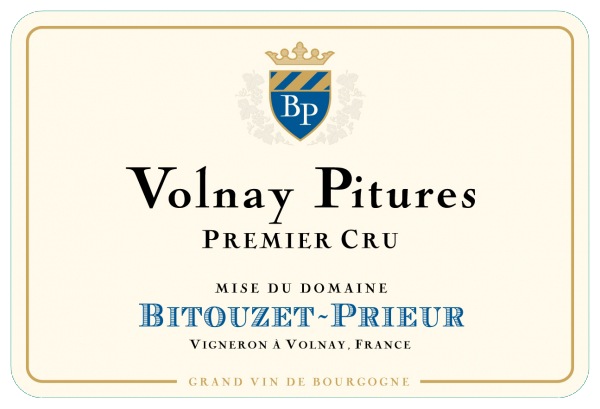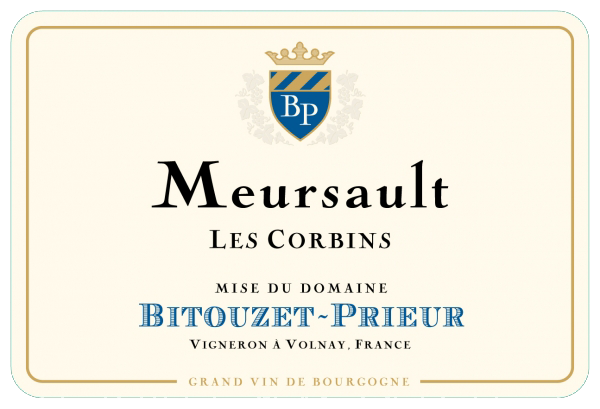
Domaine Bitouzet-Prieur
Wines

Meursault
Volnay 1er Cru, “Clos des Chênes”
The domaine possesses two parcels of Pinot Noir in this highly regarded premier cru, one mid-slope with browner soil, and one high-slope with whiter soil, planted between 1976 and 1986, totaling just over a half-hectare. This cuvée is one of dynamism, balance, and drive, and although there is marked tension between its vigorous acidity, soaring aromatics, and thickly rendered fruit, its dominant sensibility is one of regal poise. It is the most linear, most kinetic wine in the Bitouzet cellar, and it is stunning in every vintage, particularly with cellar age.
Volnay 1er Cru, “Caillerets”
We consider this cuvée to be the consistently most outstanding red wine of this estate. It has grace and power combined, round on the palate, with fine, long tannins, excellent density; a brooding beauty with depth and character galore but sadly of extremely limited availability. The Bitouzets own a mere 0.15 hectare of Caillerets. The vines were planted in 1981. Magnums are always part of our program with the Caillerets.
Volnay 1er Cru, “Taillepieds”
This cuvée is one of the most complete representations of the complexity that can be found in the finest Volnays as it is from one of the great vineyards of that village. Bitouzet owns 0.72 hectares in this renowned mid-slope premier cru, planted in 1971, 1983, and 1997. The poor, hard limestone soils of Taillepieds produce a wine of thundering minerality whose presence is felt even through its blatantly salty finish, and the savory red fruits and subtle floral notes, gorgeous as they are, take a backseat to this overarching impression of mother-rock.
Volnay 1er Cru, “Pitures”
Although it hails from a lesser-known site than some of the domaine’s other wines, François always serves his Pitures last in the lineup, and for good reason: this cuvée offers the sternest, firmest, most elemental sense of structure of all the Volnay premier crus in the cellar. Situated near the Pommard border and adjacent to the fabled Clos des Ducs vineyard, Pitures expresses the broad, sanguine fruit more typically associated with Pommard, although a profound Volnay-esque sense of elegance permeates it as well. Bitouzet’s vines here were planted between 1959 and 1974 and encompass just shy of a hectare.
Volnay 1er Cru, “Mitans”
Les Mitans is situated towards the center of the appellation and is a classic Volnay with breed and finesse supported by a sturdy backbone. In tribute to our long and close relationship, the Bitouzets have allotted the entire production (three barrels) to us for the US market, as Bitouzet only has a 0.13-hectare sliver of vines that were planted in 1991 in the En l’Ormeau section of Les Mitans. Firm and dark in fruit character, it offers a lurking mineral-driven power and a counterbalancing floral element.
Volnay 1er Cru, “Les Aussy”
Bitouzet owns 0.5 hectares of Pinot Noir in this vineyard (incorporated into neighboring Le Ronceret since 2006) which sits just below En Champans on the slope; half was planted in 1948, and the other half in 1998. With its pretty spice element, elegant floral notes, and taut red fruits, this cuvée offers a supple, silken texture and subdued tannins—a quintessential Volnay, and the most open and approachable of François’s premier crus.
Volnay
Bitouzet’s exemplary Volnay comes from 2.2 hectare’s worth of holdings planted between 1961 and 2003 in three sites: Les Petits Gamets, Ez Echards, and the villages-level portion of Les Aussy. Aged for 16 months in a modest 10% new oak, it is of a piece with the domaine’s loftier premier cru cuvées, emphasizing impeccable purity of fruit and haunting balance, and underpinned by enough structure to allow for gradual and striking improvement in the cellar.
Beaune Rouge 1er Cru, “Cent-Vignes”
The sole red offering from this domaine outside of Volnay is the Beaune 1er Cru Cents-Vignes which is also perhaps the most charming red wine of the estate. It shows this appellation’s typical soft tannins and gracious red cherry fruit; supple, silky, and fine with excellent balance and beautifully ripe fruit. The Bitouzets own 1.26 hectares of vines here which were planted in 1987 and 1988.
Bourgogne Rouge
Bitouzet’s formidable Bourgogne Rouge comes from a hectare’s worth of Pinot Noir planted between 1963 and 1970 in the lieu-dit Petit Près, situated just below the villages-level Volnay vineyard Les Pasquiers near the Meursault border. Aged entirely in used barrels for 12 months, it leads with fruit—small-berried, finely etched fruit—but possesses ample minerality and a notable sense of refinement for its level.
Bourgogne-Passetoutgrains, “Grange le Duc”
Francois’s Bourgogne Passetoutgrains, from the Grange le Duc vineyard adjacent to Volnay proper, comprises 70% Pinot Noir (planted in 1974) and 30% Gamay (planted in 1953), and it spends one year in used 228-liter barrels. Juicy yet with a Volnay-like sense of savory earth, its finesse and equilibrium allow it to sit comfortably alongside Bitouzet’s wines from more hallowed terroirs.
Puligny-Montrachet, “Les Levrons”
Bitouzet’s lone Puligny-Montrachet is produced from a 0.6-hectare 1955 planting (half replanted in 2000) in the lieu-dit Les Levrons, which lies just below premier cru Les Referts on the slope in the northern part of the village. François crafts a Puligny of impeccable, crystalline clarity from this site, with more filigree, citrus-tinged fruit than his Meursaults, but with an equally authoritative, if less weighty, undercarriage of earth-derived minerality. It spends 16 months in 20-25% new barrels during its élevage.
Meursault 1er Cru, “Perrières”
François owns just over a quarter-hectare of Chardonnay, planted in 1983, in the lower part of this fabled premier cru (Les Perrières Dessous) , situated immediately above Les Charmes on the slope. Always the most dazzlingly mineral wine in their lineup, Bitouzet’s Meursault-Perrières offers a tight-grained, tunneling, borderline saline palate that can be almost overwhelming in youth, but unfailingly blossoms gradually into a white Burgundy of layered majesty. 25-30% new oak is employed in its 16-month élevage.
Meursault 1er Cru, “Charmes”
Bitouzet’s Meursault-Charmes is one of the greatest and most iconic white wines in the RWM portfolio. The family owns a total of 0.55 hectares in this renowned cru, divided between two plots—one in the upper part of the vineyard (“Dessus”) and one in the lower part (“Dessous”)—vinified separately and then blended together before bottling to create a wine of outstanding complexity, with great finesse and power. The lower section provides a stony minerality and an almost tannic expression; the upper section yields explosive aromatics as well as a round, buttery mouthfeel. Most of Bitouzet’s vines here were planted in 1944, with a portion planted in 1987, and this sees 25-30% new oak during its 16-month élevage.
Meursault 1er Cru, “Santenots”
This unique premier cru sits right on the border of Meursault and Volnay; white wines from here are labeled Meursault, and red wines Volnay, and Francois owns a fifth of a hectare of Chardonnay in the steep Santenots-Blanc climat, planted in the early 1970s. The plot’s soils of Bathonian limestone and brown scree produce a broad, powerful wine that combines rich body and punchy minerality in an impressively dynamic whole. This passes 16 months in about one-quarter new barrels before bottling.
Meursault, “Clos du Cromin”
Clos du Cromin is a walled site within the larger lieu-dit of Le Cromin, situated immediately upslope from Bitouzet's other Meursault parcel, Les Corbins in the northern sector of the appellation. Planted in 1951, Bitouzet’s third of a hectare of Chardonnay here yields a more mineral-driven, structurally stricter wine than Les Corbins, yet one which still shows ample flesh despite its youthful reticence, developing with time into a rich, well-balanced wine with a long finish. It spends 16 months in 20% new oak and is bottled after the second winter following harvest.
Meursault, “Les Corbins”
Southeast-facing Les Corbins is located north of the village of Meursault on the way to Volnay, just underneath the premier cru Les Plures. François owns a hectare and a half of Chardonnay here, planted between 1974 and 1987; the soil is a particularly deep and rocky clay-limestone mix. Aged 16 months in 20% new barrels, it’s a textbook Meursault, combining intense minerality with a subtle buttercream note, and plenty of acid-driven tension as per the Bitouzet house style.
Bourgogne Blanc
Bitouzet works a 0.71-hectare parcel of vines in the lieu-dit Les Herbeaux in northern Meursault, adjacent to premier cru Les Malpoiriers, and planted in the early 1950s (with a portion replanted in 2010). Aged 12 months on its fine lees in 228-liter barrels, a maximum of 15% of which are new, the domaine’s Bourgogne Blanc presents as a Meursault in miniature, with sneaky power, pronounced salinity, and a tightly coiled structure that rewards a few years of cellaring.
Bourgogne Aligoté, “Les Grandes Terres”
François Bitouzet produces a beautifully textured Aligoté from a parcel that was planted above Meursault in 1975, and the age of the vines provides low yields of around 50 hl/ha, crucial for this workhorse grape. The wine is fermented and settled in tank then rests in used 228-liter barrels on the fine lees from his production of Meursault Premier Cru, adding complexity and density. This kind of quality from the Aligoté grape is rare and we encourage clients to jump all over it—In fact, we love it so much that we secured an exclusive to the US and bring in the entire production, just under 150 cases.



















